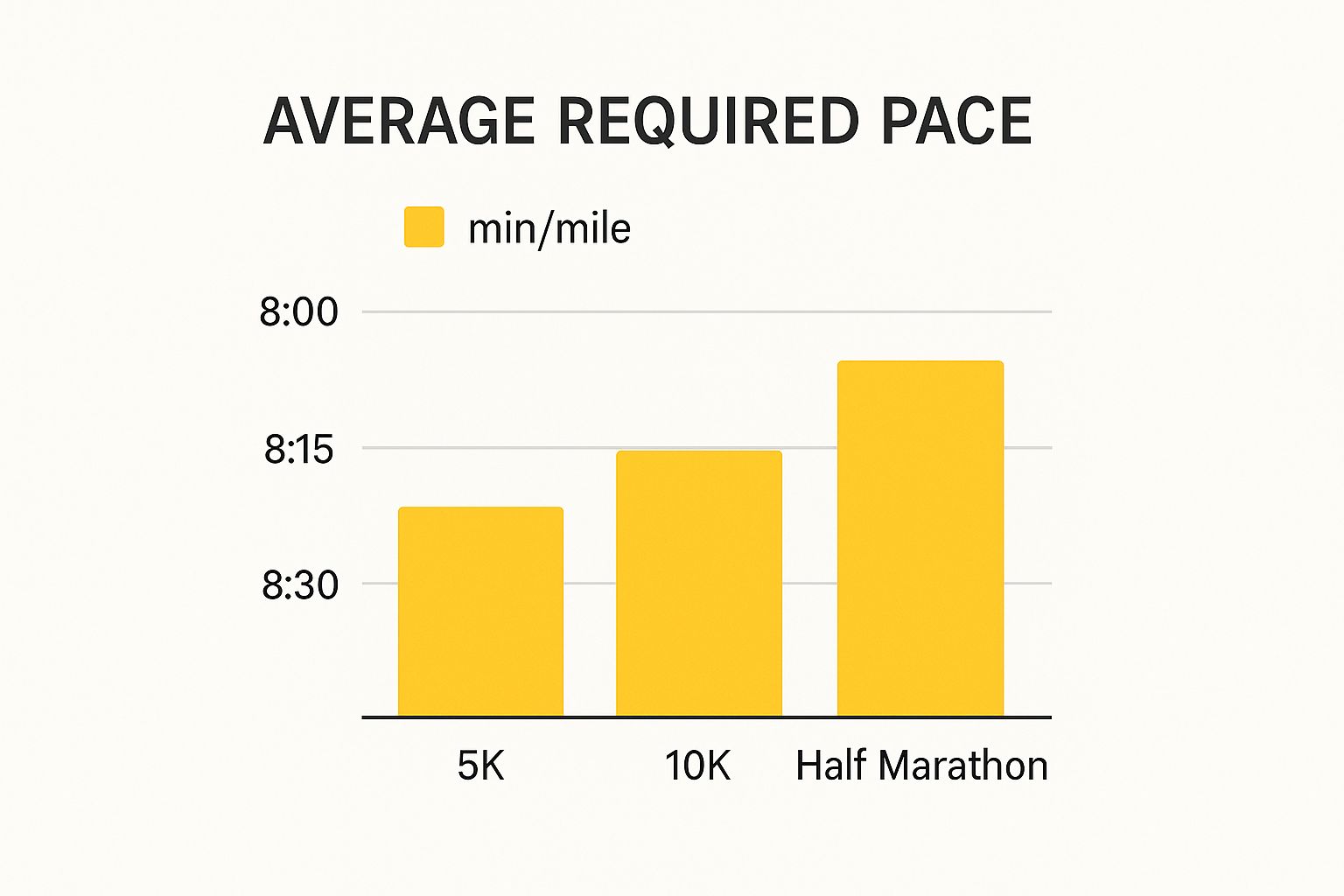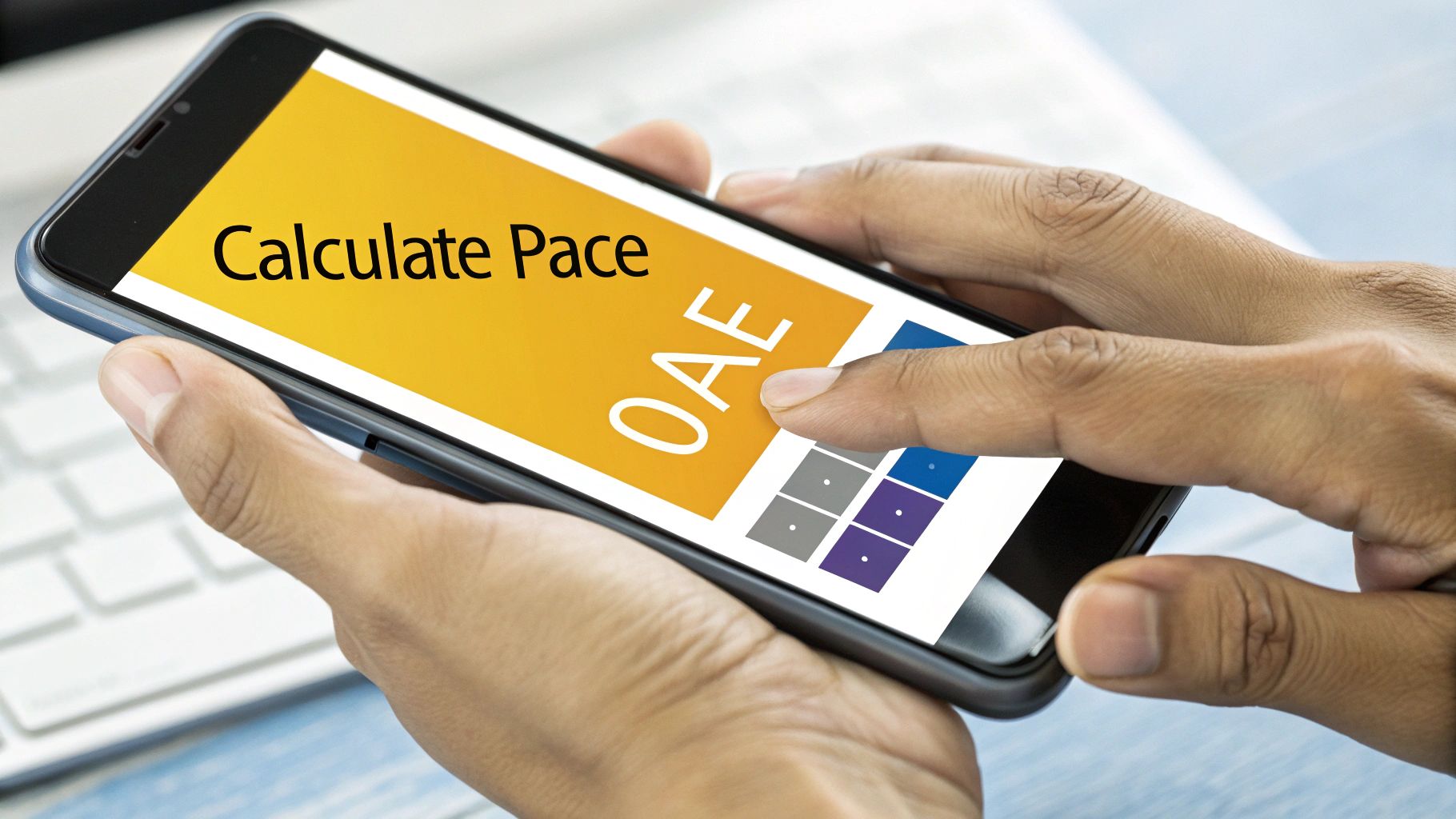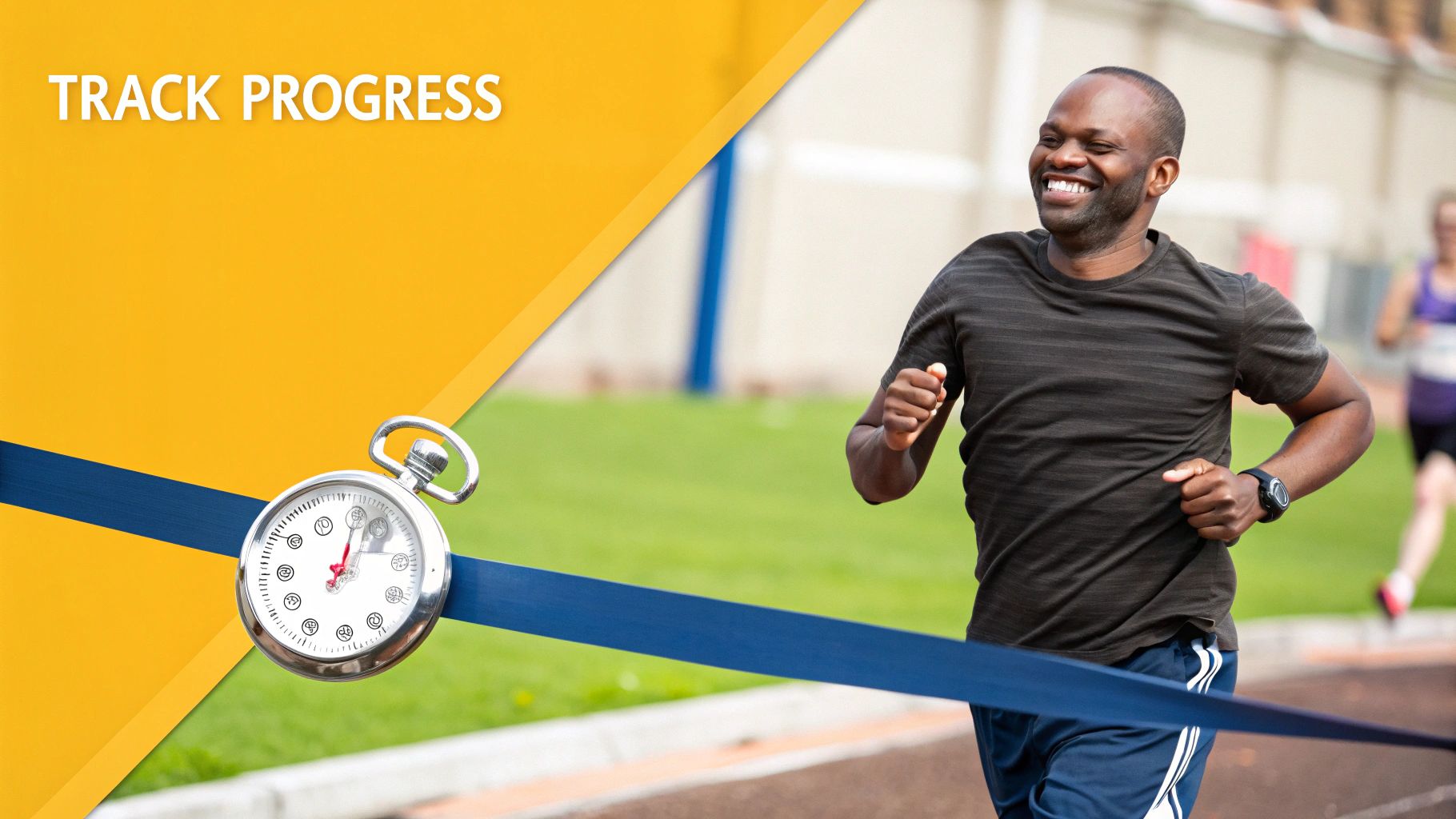Race Pace Calculator Mastery: Transform Your Running Success
Understanding Race Pace Calculators That Actually Work

Race pace calculators are helpful tools for runners aiming for specific finish times. They help determine the pace needed throughout a race, allowing runners to approach training with a clear goal. This means knowing exactly how fast to run during training sessions.
Runners in the UK have increasingly adopted race pace calculators to improve their performance. Tools like the Runner’s World Race Time Predictor allow runners to input recent race times and weekly mileage to estimate target race finish times. This is especially helpful for those preparing for events like the London Marathon or the Great North Run.
Runners can better understand their current fitness level and set achievable race goals. For example, a runner with a recent 5K time of 25 minutes can use a calculator to estimate their potential half marathon finish time. This offers a structured approach to training. Learn more: Runner’s World Race Time Predictor .
Why Accuracy Matters in Race Pace Calculation
Not all race pace calculators are equally accurate. Choosing one that uses dependable data and algorithms is essential. Accurate predictions are crucial because inaccurate ones can lead to disappointment on race day. Inaccurate pacing can also increase the risk of injury from overtraining.
Different Types of Race Pace Calculators
Various types of race pace calculators exist, each with a different purpose. Basic pace calculators simply convert time and distance into pace. Advanced race predictors, however, consider factors like training data and previous race results. Training zone tools help determine optimal heart rate zones for different training runs. This variety allows runners to find tools tailored to their specific needs. For example, How to master HYROX pacing offers pacing strategies for HYROX races.
Factors Affecting Calculator Accuracy
Several factors impact a race pace calculator’s accuracy. One key factor is the accuracy of the input data, such as recent race times. The specific algorithm the calculator uses also plays a role. External factors like weather and course terrain can also significantly influence actual race pace. British weather is known for its unpredictability. Difficult course profiles, especially in fell races, can further impact race pace. Therefore, it’s important to consider these variables when interpreting race pace calculations.
Interpreting and Applying Calculator Results
Race pace calculators, even the most accurate ones, should be used as guides, not guarantees. Interpreting the results within the context of your own training and experience is important. For instance, if a calculator predicts a significantly faster time than you’ve ever run before, it’s crucial to be realistic about its achievability.
Adjusting goals based on calculator feedback and real-world training is key. This helps in setting realistic goals and avoiding overtraining or discouragement. A runner’s self-awareness becomes just as important as the calculated numbers.
Using a race pace calculator strategically can improve training and race day performance. By understanding their limitations and interpreting the results realistically, runners can maximize their potential.
Finding The Best Race Pace Calculator Tools For UK Runners

This infographic illustrates the average paces needed for target finish times in common race distances: 5K, 10K, and Half Marathon. Notice how maintaining a consistent pace becomes more critical as the distance increases. A small pace difference might not dramatically affect your 5K, but it can significantly impact your half marathon time.
Finding a reliable race pace calculator is essential for any UK runner, from seasoned marathoners to weekend Parkrun enthusiasts. The key is finding a calculator that offers accurate predictions and helpful training guidance.
Why Choosing the Right Calculator Matters
Numerous race pace calculators are available, but their accuracy and features differ. Some are great for predicting marathon times, while others excel with shorter distances. This is due to the varying algorithms used. Some calculators incorporate more data points than others, like recent race performance, training volume, and even elevation changes often found in UK races.
Top UK Race Pace Calculators
The search for the ideal race pace calculator can be daunting. However, focusing on essential features simplifies the process. Consider factors like accuracy, ease of use, and whether the calculator adapts to UK-specific race conditions. British weather is famously unpredictable, so calculators that adjust for this are beneficial.
-
Vdot Calculators: These use your recent race times to determine your Vdot, a metric reflecting your overall running fitness. Your Vdot then predicts your potential race times across different distances.
-
Race Time Predictors: Often featured on sites like Runner’s World , these calculators let you input various data (recent race times, weekly mileage) to estimate finish times. They’re typically simpler than Vdot calculators but still offer helpful estimations.
-
Training Zone Calculators: These establish your heart rate training zones based on your maximum heart rate or lactate threshold. Using these zones during training can boost your efficiency and overall performance, especially for hilly UK routes.
To help you choose the best calculator, we’ve compiled a comparison of some popular options:
Top UK Race Pace Calculator Comparison
Comprehensive comparison of the most popular race pace calculators used by UK runners, including features, accuracy, and best use cases
| Calculator Name | Key Features | Race Types Supported | Accuracy Rating | Cost |
|---|---|---|---|---|
| Vdot Calculator (Jack Daniels) | Uses VDOT, considers various factors | Wide range, from 5k to Marathon | High | Free/Paid options |
| Runner’s World Race Time Predictor | Simple input, based on past performance | Various distances | Moderate | Free |
| TrainingPeaks Pace Calculator | Considers training load and other metrics | Customizable | High | Requires TrainingPeaks account |
| McMillan Running Calculator | Advanced calculations, detailed analysis | Comprehensive range | High | Paid |
This table provides a quick overview of different calculators, highlighting their strengths and weaknesses. Consider your specific needs and preferences when making your choice.
Evaluating Calculator Reliability
Before relying solely on any calculator’s predictions, evaluate its reliability. One key indicator is whether it incorporates training data for more personalized predictions. Also, check if it accounts for UK-specific factors like challenging terrains often found in events like the Great North Run. Finally, seek out real user experiences and reviews from other British runners. This provides valuable insights into a calculator’s accuracy and practicality. By carefully assessing these factors, you can choose a race pace calculator that helps you set realistic goals and reach your running potential in the UK. Consistent training and accurate pace calculations are key ingredients for race day success.
Tracking Progress And Setting Realistic Goals With Calculator Data

A race pace calculator is more than just a tool for race day; it’s a valuable resource for monitoring your running progress and setting achievable goals. This means shifting your focus from solely aiming for faster times to concentrating on consistent, measurable improvements.
Think about it: are you maintaining a steadier pace during your long runs? Are your easy runs truly easier at the same heart rate? These are key indicators of real progress.
Using Data to Refine Your Training
Many successful UK runners use race pace calculators to track improvements in key metrics. By inputting data from training runs and races, you can identify your strengths and weaknesses.
This data-driven approach allows you to strategically adjust your training plan, focusing on areas that need improvement. For instance, you might find you need to work on speed work or increase your long run mileage. You might be interested in: How to master a hybrid training program . This targeted training is especially helpful when preparing for major British events like the London Marathon or the Great North Run.
Tracking your progress with a race pace calculator also helps you set realistic personal best targets. By analyzing your current pace and predicted finish times, you can establish goals that are both ambitious and achievable. This helps maintain motivation, especially during challenging training periods.
Running pace calculators are also beneficial for tracking progress and setting new personal bests. Websites like Start Fitness offer running pace calculators that let athletes input their distance and time to calculate their pace in minutes per mile or kilometer. This helps runners monitor their progress and adjust their training accordingly. Start Fitness Pace Calculator . For example, if a runner wants to finish a 10K in under 50 minutes, the calculator can determine the required pace to reach this goal. Regularly using these tools allows runners to track improvements in their speed and endurance, particularly useful for those training for popular UK races like the Brighton Marathon or the Manchester Half Marathon.
Interpreting Calculator Results
It’s crucial to remember that calculator predictions are just that – predictions. Factors like British weather, course difficulty, and even your mental state on race day can affect your actual performance.
However, by understanding which metrics indicate actual fitness gains versus temporary fluctuations, you can interpret the calculator’s feedback more effectively. This involves recognizing the difference between a good training run and a truly representative performance indicator. Consistent tracking and honest self-assessment are vital.
Practical Tips for Using a Race Pace Calculator
-
Accurate Data Input: Begin with precise data about your recent race times or your estimated current fitness level.
-
Contextualize Results: Consider your running history and training load when interpreting the calculator’s output. A predicted pace might be too ambitious if you’re just starting out.
-
Realistic Training Timelines: Use the predicted pace to create a realistic training plan that allows for gradual progression and sufficient recovery. Don’t try to increase your pace too quickly.
By following these tips, you can utilize a race pace calculator as an effective tool for achieving consistent performance improvements.
Mastering Advanced Features: Critical Pace and Training Zones
A race pace calculator can do more than just predict finish times. It can unlock advanced metrics like critical pace and training zones, fine-tuning your training, especially for demanding UK events like ultra-marathons and fell races. This provides a deeper understanding of your physiological capabilities, going beyond basic pace calculations.
Understanding Critical Pace
Critical pace represents the effort you can maintain at a high intensity without hitting the wall. Think of it as the pace you could theoretically hold indefinitely (in ideal conditions, of course). This makes it a valuable benchmark for structuring challenging workouts.
Knowing your critical pace can inform the ideal intensity for your tempo runs, helping you avoid overexertion early in a race. It’s about finding that sweet spot where you push yourself without burning out.
In the UK, critical pace has gained attention as a valuable training metric. Tools like High North Running’s Critical Pace Calculator help runners determine their critical pace and power, allowing them to tailor training to specific intensity zones. This is particularly useful for UK runners tackling events requiring sustained effort, like ultra-marathons or long-distance trail running. Learn more about Critical Pace for Runners .
By understanding their critical pace, runners can better manage training, ensuring sessions are challenging yet avoid overtraining. For instance, a runner with a 7-minute-per-mile critical pace can use this to structure interval workouts and endurance runs, enhancing race performance.
Power-Based Metrics and Training Zones
While pace remains fundamental, power-based metrics are gaining traction, especially for trail and fell running where terrain significantly impacts effort. Power data offers a more consistent exertion measure regardless of the hills and dales common in UK races.
However, pace and power complement each other. Use pace for flat road races and power for hillier routes. Knowing both gives a more complete picture of your effort. You might be interested in: How to master your training zones .
Applying Critical Pace to Training
Understanding your critical pace can transform your training. Consider how your calculated critical pace translates to these training zones:
-
Easy Runs: Run significantly slower than your critical pace to recover and build an aerobic base.
-
Tempo Runs: Run near your critical pace to improve your ability to sustain speed without fatiguing.
-
Interval Training: Run faster than your critical pace in short bursts to boost speed and power.
By structuring training around these zones, you can avoid overtraining and maximize race-day performance. Proper pacing in training is crucial for avoiding injuries and optimizing overall fitness.
Building Training Plans That Actually Use Calculator Insights
A race pace calculator provides a target, but turning that into a practical weekly training schedule is the real challenge. This section explores how experienced UK runners and coaches connect the dots between theoretical pace and real-world training, building plans that genuinely utilize calculator insights. It’s about going beyond simply knowing your target pace and understanding how to integrate it into a comprehensive training strategy.
Incorporating Calculated Paces into Workouts
How do you actually use your calculated race pace in training? It isn’t about running at that pace constantly. Instead, incorporate it strategically into different types of workouts.
For instance, your calculated pace can guide the intensity of your tempo runs, those sustained efforts designed to build stamina. It can also be a benchmark for interval training, where you alternate high-intensity bursts above your race pace with recovery periods.
Even easy runs can benefit from calculator insights. Ensuring your easy runs are sufficiently slow promotes recovery and prevents excessive fatigue. This balance of intensity is crucial for progress.
Periodization for UK Races
Periodization, structuring your training into distinct phases, becomes more effective with calculator data. Knowing your target race pace helps define the right intensity for each training phase.
Whether preparing for a spring marathon like the London Marathon or an autumn half-marathon like the Great North Run , use the calculator’s predictions to create a periodized plan that optimizes your fitness at the right time. This ensures you’re neither overtrained nor underprepared on race day.
Adapting to Calculator Recommendations
Sometimes, the calculator’s recommendations might seem overly ambitious or perhaps too conservative. Remember that calculators are tools, not dictators. They provide guidance, but you adapt that guidance to your personal circumstances.
Factors like training history, current fitness level, and lifestyle influence how you incorporate calculated paces. Listen to your body and adjust your plan as needed. Consistency is key, and sometimes that means deviating slightly from the calculator’s initial suggestions. Read also: How to master 5k pacing .
Maintaining Consistency and Motivation
The most complex training plan is worthless if you can’t follow it. When calculator recommendations feel too challenging, it’s easy to get discouraged. Conversely, if the suggested paces seem too easy, you might lose motivation.
Maintaining training consistency requires balance between pushing yourself and respecting your body’s limits. Honest self-assessment and communication with a coach, if you have one, are invaluable. By acknowledging potential challenges and developing strategies to overcome them, you can stay on track toward your race goals. This mental resilience is as important as the physical training.
Avoiding Calculator Pitfalls That Derail Race Success
Race pace calculators can be excellent tools for runners, offering potential insights into pacing strategies and predicted finish times. However, these digital tools aren’t foolproof. Understanding their limitations is crucial for effectively using their predictions and avoiding common training and racing pitfalls.
Over-Reliance on Single Data Points
One common mistake is over-relying on a single stellar performance when inputting data. A personal best at a local 5k on a cool, calm day doesn’t guarantee the same pace during a hilly half marathon on a hot, humid day. UK weather is notoriously unpredictable, adding another layer of complexity.
Instead of focusing on one exceptional run, consider using an average of your recent performances. This provides a more balanced and realistic baseline for the calculator’s predictions. Think of it like preparing for an exam: consistent study habits generally lead to better results than cramming the night before.
Ignoring Personal Factors
Calculators often fail to account for personal factors like sleep, stress, and nutrition, all crucial elements impacting race day performance. A stressful week at work or a poor night’s sleep can significantly impact your pace and endurance.
Be realistic about your lifestyle and training consistency. If you’ve been consistently training three times a week, don’t expect a calculator based on five or six sessions to be accurate. Honesty about your training volume leads to more reasonable predictions.
Unrealistic Expectations
Setting unrealistic expectations based solely on a calculator’s output is another common pitfall. If you’ve never run a sub-20 5k, it’s unlikely a calculator will predict an 18-minute finish just because your weekly mileage has slightly increased.
Progression requires time and dedicated effort. Treat calculator predictions as a helpful guide, not a guaranteed outcome. Gradual improvement over several races is a more sustainable and less risky approach than aiming for a drastic, potentially injury-inducing jump.
The Impact of UK Conditions
British weather and diverse course terrains can dramatically affect your race day experience. A hilly course like the Snowdonia Marathon demands a different pacing strategy than a flatter, faster course like the Reading Half Marathon .
Unpredictable weather, from strong winds to heavy rain, presents another challenge. Be prepared to adjust your race strategy on the day, taking these external factors into account.
Using Data as a Guide, Not Gospel
To understand the numerous factors influencing race pace calculator accuracy, let’s take a closer look at a breakdown of these variables. The following table highlights how environmental and personal factors can impact your race predictions, specifically within the context of UK running conditions.
Race Pace Calculator Accuracy Factors
Key factors that influence the accuracy of race pace calculator predictions for UK runners, including environmental and personal variables
| Factor | Impact on Accuracy | UK-Specific Considerations | Adjustment Recommendations |
|---|---|---|---|
| Weather Conditions | Significant | Frequent rain, wind, and temperature fluctuations | Check the weather forecast before the race and adjust pace targets accordingly |
| Course Terrain | High | Hilly routes common in events like the Three Peaks Race | Train on similar terrain and factor in elevation gain |
| Training Consistency | Major | Life demands can disrupt training schedules | Be realistic about training volume and adjust expectations |
| Recent Race Performance | High | Consider the conditions of previous races | Use an average of recent race times in similar conditions for better accuracy |
Race pace calculators are undoubtedly valuable tools, offering useful insights into your potential. However, they are just one piece of the performance puzzle. By understanding their limitations, being mindful of personal factors, and adapting to the specific conditions of UK races, you can use these tools effectively to help achieve your running goals. Remember, data serves best as a guide, not an absolute guarantee. Flexibility in training and racing is key to long-term success.
Race Day Execution: Turning Calculator Predictions Into PBs

Race day is the culmination of your hard work and training. It’s where those race pace calculator predictions are put to the test. To maximize your chances of hitting that predicted time, or even surpassing it, you need a combination of strategic planning and in-race adaptability. A solid race plan is essential, but so is the flexibility to adjust on the fly.
Pacing Strategies for UK Races
Using a race pace calculator effectively means understanding various pacing strategies. A negative split, where the second half of your race is faster than the first, is often favored by seasoned runners. This approach demands careful pacing early on to conserve energy for a powerful finish.
Even pacing, on the other hand, focuses on maintaining a consistent speed throughout the race. This can be particularly beneficial given the unpredictable nature of UK weather. It helps ensure you don’t burn out too early if conditions take a turn for the worse.
Some runners might opt for a tactical surge during specific sections of the race. This strategy is often seen in shorter distances or races with varying terrain, both common in UK events. Your race pace calculator can be instrumental in determining the optimal target pace for these sections.
Mental Preparation and Race Day Challenges
Mental toughness is just as important as physical conditioning. Visualizing the race and practicing positive self-talk can have a significant impact on your race day performance. Being mentally prepared for challenges like crowded starts, often encountered in popular UK races, or managing mid-race fatigue, will help you stay on track.
Practical Advice for Race Day Success
-
Warm-up: Even with the race day excitement, don’t skip a proper warm-up. It primes your muscles and mind for optimal performance.
-
Hydration and Fuel: Stick to your pre-race nutrition and hydration plan. Even slight deviations can impact your energy levels, particularly over longer distances.
-
Adapt to Conditions: British weather can be notoriously changeable. Be ready to adapt your pace and clothing based on the conditions you face on race day.
-
Listen to Your Body: While your race pace calculator gives you a target, it’s essential to listen to your body. If you’re feeling good, consider pushing the pace a bit. If you’re struggling, don’t hesitate to slow down and conserve energy.
By combining your race pace calculator predictions with a flexible race plan and a strong mental game, you’ll be well-prepared to achieve your running goals. You’ll be ready to tackle whatever challenges the UK weather or the race itself may present.
Ready to optimize your Hyrox training and shatter your personal best? Kracey offers personalized training plans, pace calculators, and expert guidance to help you conquer your next race. Visit Kracey today to start your journey towards peak performance.
Table of Contents
- Understanding Race Pace Calculators That Actually Work
- Why Accuracy Matters in Race Pace Calculation
- Different Types of Race Pace Calculators
- Factors Affecting Calculator Accuracy
- Interpreting and Applying Calculator Results
- Finding The Best Race Pace Calculator Tools For UK Runners
- Why Choosing the Right Calculator Matters
- Top UK Race Pace Calculators
- Evaluating Calculator Reliability
- Tracking Progress And Setting Realistic Goals With Calculator Data
- Using Data to Refine Your Training
- Interpreting Calculator Results
- Practical Tips for Using a Race Pace Calculator
- Mastering Advanced Features: Critical Pace and Training Zones
- Understanding Critical Pace
- Power-Based Metrics and Training Zones
- Applying Critical Pace to Training
- Building Training Plans That Actually Use Calculator Insights
- Incorporating Calculated Paces into Workouts
- Periodization for UK Races
- Adapting to Calculator Recommendations
- Maintaining Consistency and Motivation
- Avoiding Calculator Pitfalls That Derail Race Success
- Over-Reliance on Single Data Points
- Ignoring Personal Factors
- Unrealistic Expectations
- The Impact of UK Conditions
- Using Data as a Guide, Not Gospel
- Race Day Execution: Turning Calculator Predictions Into PBs
- Pacing Strategies for UK Races
- Mental Preparation and Race Day Challenges
- Practical Advice for Race Day Success